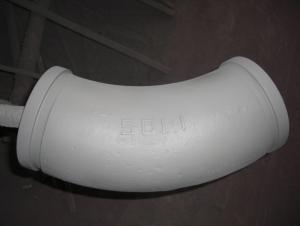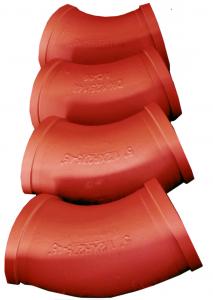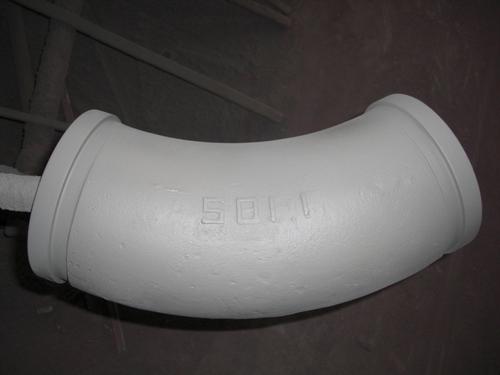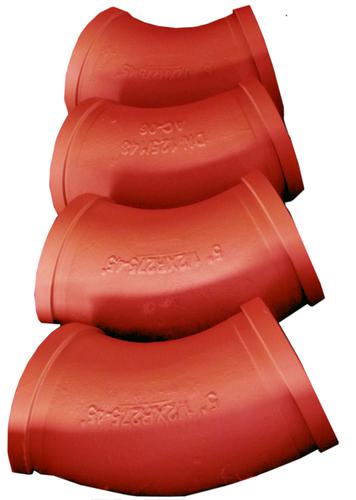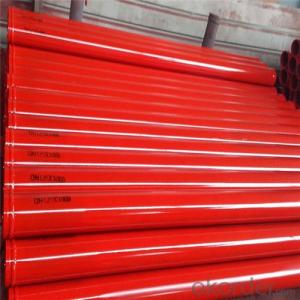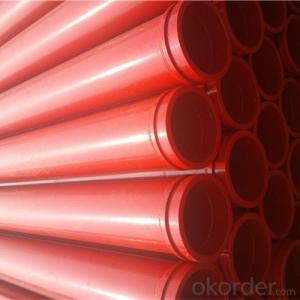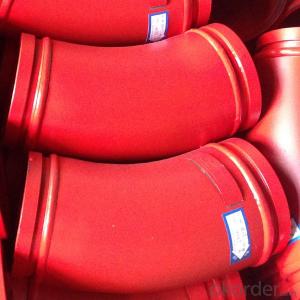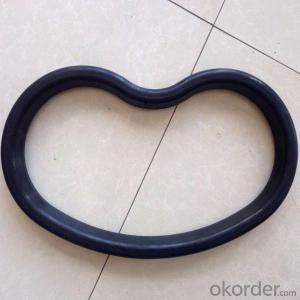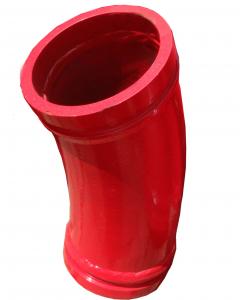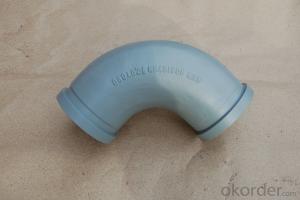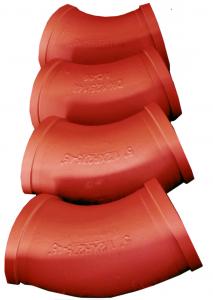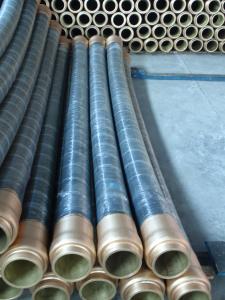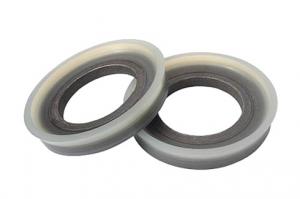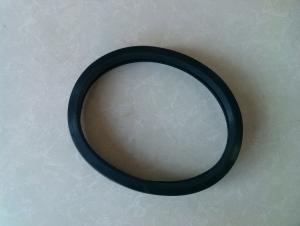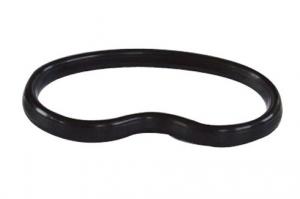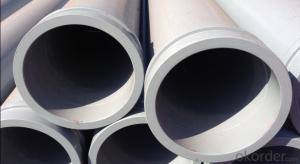Concrete Pump Truck Parts Elbow Bend DN100 R275 45DGR 148MM Mn13-4 Casting
- Loading Port:
- China Main Port
- Payment Terms:
- TT OR LC
- Min Order Qty:
- -
- Supply Capability:
- -
OKorder Service Pledge
Quality Product, Order Online Tracking, Timely Delivery
OKorder Financial Service
Credit Rating, Credit Services, Credit Purchasing
You Might Also Like
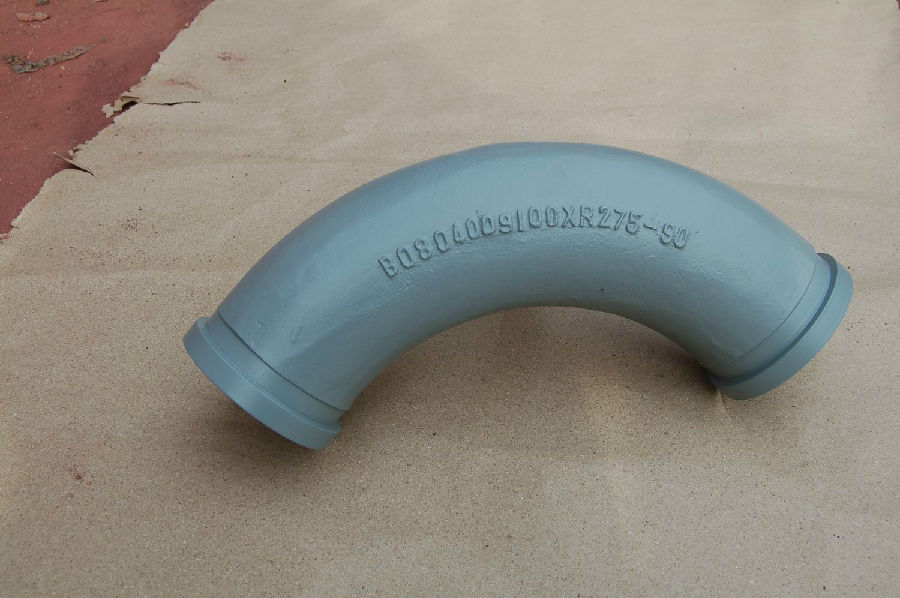
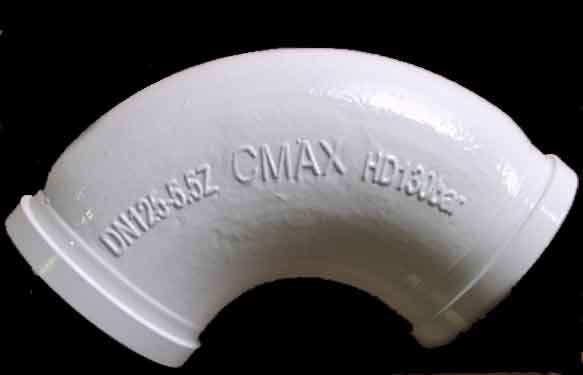
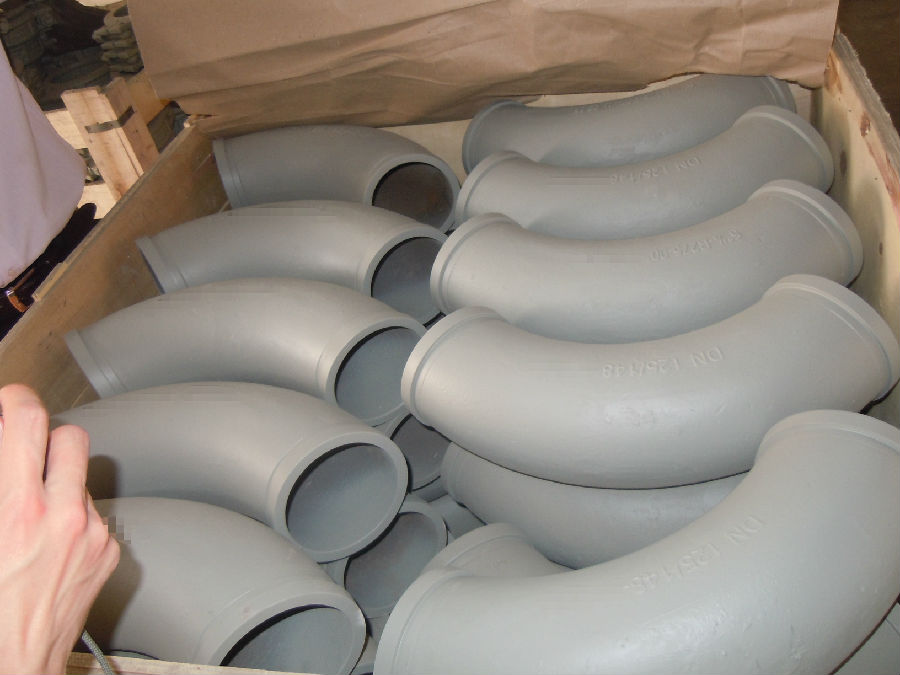
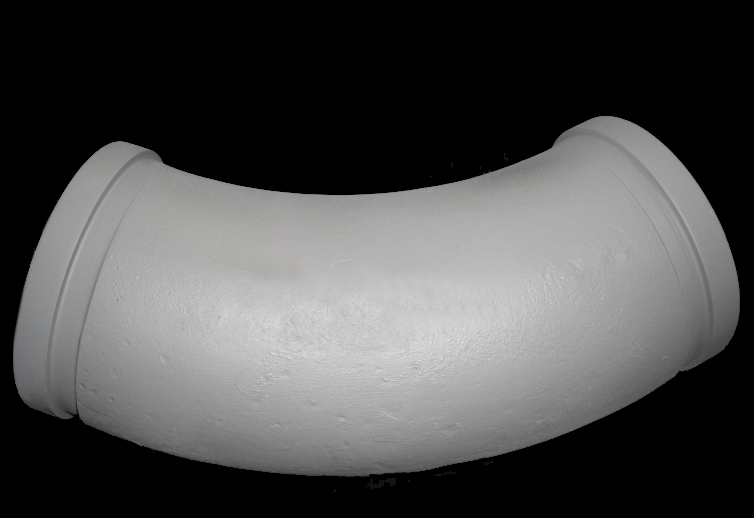
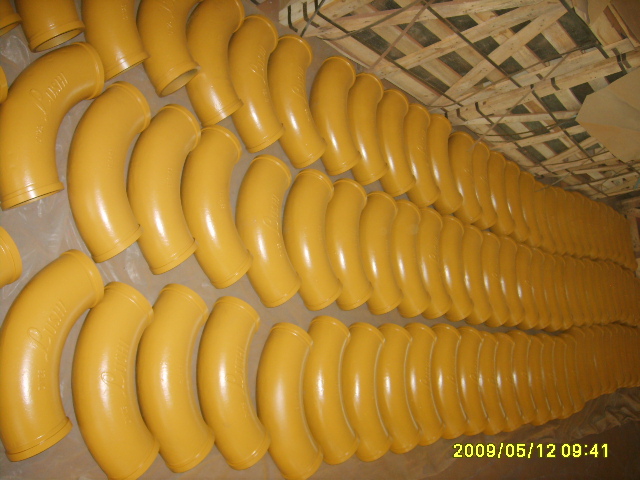
Product Description:
Product Name: Concrete Pump ELBOW DN100
1. Specification of Concrete Pump ELBOW DN100
Dimensions: DN100
Radius: 275mm
Flange: SK, ZX, F&M
Degree: 45
Material: #20 steel, ST52
Thickness: 4.5mm,6mm,7.1mm,7.5mm,10mm,
Working pressure: 180MPa
Notes: total series of concrete pump ELBOW for different brand concrete pump(PUTZMEISTER, SCHWING, CIFA, SANY, ZOOMLION, IHI, KYOKUTO Etc) available from us.
2. Application of Concrete Pump ELBOW DN100
Widely used on concrete pump truck, concrete placing boom, trailer concrete pump etc, for concrete delivery pipe connection.
Our concrete pump bends have been successfully exported to many countries from 1998, Our main markets as below: Middle East, Southeast Asia, America, Brazil, Italy, Russia, South Africa etc
Aiming at the largest concrete pump parts manufacturer, and reliable, professional supplier in China, we can supply concrete pump elbows, delivery pipes, casting or forging couplings, end rubber hoses, rubber pistons, tungsten wear plates, delivery cylinders, and other hydraulic parts, one stop service for your concrete pump parts and accessory business.
3. Package and Delivery of Concrete Pump ELBOW
Every 30pcs put in one seaworthy wooden box, and 20 boxes in one 20feet container.
Product Name: Concrete Pump ELBOW DN100
1. Specification of Concrete Pump ELBOW DN100
Dimensions: DN100
Radius: 275mm
Flange: SK, ZX, F&M
Degree: 45
Material: #20 steel, ST52
Thickness: 4.5mm,6mm,7.1mm,7.5mm,10mm,
Working pressure: 180MPa
Notes: total series of concrete pump ELBOW for different brand concrete pump(PUTZMEISTER, SCHWING, CIFA, SANY, ZOOMLION, IHI, KYOKUTO Etc) available from us.
2. Application of Concrete Pump ELBOW DN100
Widely used on concrete pump truck, concrete placing boom, trailer concrete pump etc, for concrete delivery pipe connection.
Our concrete pump bends have been successfully exported to many countries from 1998, Our main markets as below: Middle East, Southeast Asia, America, Brazil, Italy, Russia, South Africa etc
Aiming at the largest concrete pump parts manufacturer, and reliable, professional supplier in China, we can supply concrete pump elbows, delivery pipes, casting or forging couplings, end rubber hoses, rubber pistons, tungsten wear plates, delivery cylinders, and other hydraulic parts, one stop service for your concrete pump parts and accessory business.
3. Package and Delivery of Concrete Pump ELBOW
Every 30pcs put in one seaworthy wooden box, and 20 boxes in one 20feet container.
- Q: How does a concrete pump agitator motor prevent concrete from settling?
- A concrete pump agitator motor prevents concrete from settling by continuously rotating and agitating the mixture, ensuring that the aggregate, cement, and water remain well-mixed. This agitation action prevents the heavier components from sinking and settling at the bottom, maintaining a homogeneous consistency throughout the concrete.
- Q: Are there any specific guidelines for the installation of sensors or transmitters in concrete pump spare parts?
- Yes, there are specific guidelines for the installation of sensors or transmitters in concrete pump spare parts. These guidelines typically include ensuring proper alignment and positioning of the sensors or transmitters, securely mounting them to prevent movement or damage, and following manufacturer instructions for wiring and connection. It is important to adhere to these guidelines to ensure accurate and reliable operation of the sensors or transmitters in concrete pump spare parts.
- Q: Are there any specific guidelines for the disposal of hydraulic fluids used in concrete pump spare parts?
- Yes, there are specific guidelines for the disposal of hydraulic fluids used in concrete pump spare parts. These guidelines typically vary depending on local regulations and environmental laws. It is generally recommended to follow the manufacturer's instructions for proper disposal methods. This may involve recycling the hydraulic fluids or disposing of them at designated waste management facilities to ensure minimal environmental impact.
- Q: How often should the concrete pump wear plate be replaced?
- The wear plate of a concrete pump needs to be replaced based on several factors such as the type and volume of concrete being pumped and the pump's operating conditions. Generally, wear plates are designed to endure a certain level of wear and tear before replacement is necessary. It is advisable to regularly inspect the wear plate to identify any signs of excessive wear, such as visible cracks, erosion, or a significant reduction in thickness. By conducting regular visual inspections, you can determine when it is time to replace the wear plate. Furthermore, monitoring the pump's performance and efficiency can offer insights into the wear and tear on the wear plate. If you notice a noticeable decrease in the pump's output or an increase in required pumping pressure, it may indicate that the wear plate needs replacement. However, it is vital to consult the manufacturer's guidelines and recommendations for your specific concrete pump model. These guidelines often provide information on the expected lifespan of the wear plate and the recommended replacement intervals. Following these guidelines will help ensure optimal performance and longevity of your concrete pump.
- Q: How often should concrete pump seals be replaced?
- Concrete pump seals should be replaced every 500 to 800 hours of operation or whenever signs of wear, leakage, or decreased performance are observed.
- Q: What are the different types of concrete pump rubber hoses?
- There are several different types of concrete pump rubber hoses available in the market. 1. Steel Wire Reinforced Hose: This is the most common type of concrete pump rubber hose. It is reinforced with multiple layers of steel wire to provide maximum strength and durability. Steel wire reinforced hoses are suitable for high-pressure applications and can handle the heavy pumping of concrete with ease. 2. Textile Reinforced Hose: This type of hose is reinforced with multiple layers of textile fabric, such as nylon or polyester. Textile reinforced hoses are generally lighter in weight compared to steel wire reinforced hoses, making them easier to handle and maneuver. They are suitable for medium-pressure applications and are commonly used in smaller concrete pumps. 3. Fabric Hose: Fabric hoses are made from a single layer of fabric, such as nylon or polyester. They are lightweight and flexible, making them easy to handle and transport. Fabric hoses are suitable for low-pressure applications and are commonly used in small-scale construction projects. 4. Composite Hose: Composite hoses are made from a combination of different materials, such as rubber and plastic. These hoses are lightweight and highly flexible, making them suitable for applications where maneuverability is crucial. Composite hoses are commonly used in smaller concrete pumps and can handle both low and medium pressure. 5. Flanged Hose: Flanged hoses have flanges attached at both ends of the hose, which are used to connect the hose to the pump and the nozzle. Flanged hoses provide a secure connection and prevent any leaks or disconnections during the pumping process. They are commonly used in high-pressure applications and are suitable for large-scale construction projects. Overall, the choice of concrete pump rubber hose depends on the specific requirements of the project, including the pressure, size, and type of concrete being pumped. It is important to select the right type of hose to ensure efficient and safe concrete pumping operations.
- Q: How long does a concrete pump piston typically last?
- The duration of a concrete pump piston's life can differ based on various factors. Typically, a concrete pump piston will endure approximately 20,000 to 40,000 cubic yards of pumping. However, this approximation can be influenced by multiple aspects, including the concrete's quality, pump maintenance and care, operating conditions, and operator expertise. Consistent maintenance and servicing, which encompass cleaning and lubricating the piston, can considerably lengthen its lifespan. It is crucial to regularly assess the wear and tear of the piston to guarantee its optimal performance and replace it as needed.
- Q: What is the function of a concrete pump remote control?
- The function of a concrete pump remote control is to allow operators to control the movement and operation of a concrete pump from a distance. This remote control enables precise and efficient placement of concrete, allowing the operator to adjust the pump's speed, direction, and other functions, ensuring the accurate and controlled delivery of concrete to the desired location.
- Q: If the concrete pump valve jam how to judge and deal with?
- After pumping concrete, be sure to use high-pressure water to pump the body and S pipe clean. When the rinse is not available, tap the tap to remove the residue until it is thoroughly clean.
- Q: In general, how much concrete will be transported per hour for the concrete pump and the pump?
- Tank car replacement, reversing the car by about 5-8 minutes
Send your message to us
Concrete Pump Truck Parts Elbow Bend DN100 R275 45DGR 148MM Mn13-4 Casting
- Loading Port:
- China Main Port
- Payment Terms:
- TT OR LC
- Min Order Qty:
- -
- Supply Capability:
- -
OKorder Service Pledge
Quality Product, Order Online Tracking, Timely Delivery
OKorder Financial Service
Credit Rating, Credit Services, Credit Purchasing
Similar products
Hot products
Hot Searches
Related keywords
